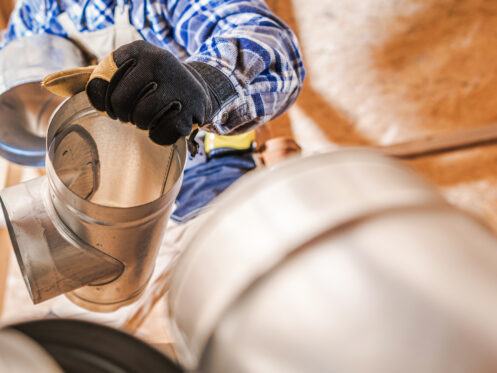Air ducts comprise one of the most important systems in your home. These ducts are important components of any HVAC system. Unfortunately, air ducts with poor insulation or sealing can contribute to higher utility bills. According to a report from the Environmental Protection Association’s ENERGY STAR program, inadequate ducts can reduce the efficiency of your HVAC system by up to 20%. This loss of efficiency has a detrimental effect on your energy costs. Fortunately, the right HVAC professionals can perform air duct sealing to restore the effectiveness of your ductwork.
What Are Air Ducts?
Air ducts are conduits or channels that deliver air from HVAC units into various rooms of the home. In most homes, air ducts look like metal tubes or vents that connect from major HVAC equipment and branch through walls, floors, ceilings, attics, basements, or crawlspaces. There are two main types of air ducts: supply ducts and return ducts. Supply ducts deliver conditioned or treated air to different areas of the home, and return ducts pull air from rooms and back into the general HVAC system. Both types of ducts play a role in indoor air quality, sufficient airflow, and thermal comfort. Most ducts or made of sheet metal, fiberglass, or PVC materials for optimal performance.
What Are Air Duct Leaks?
Duct leaks refer to air that seeps out of the ductwork due to gaps, cracks, holes, or loose joints. Typical ductwork is durable enough to operate effectively with the help of routine inspections, maintenance, and cleaning. Over time, however, duct material can wear down and crack or break. In addition, duct connections and joints are also prone to shifting and separation. These loose connections create gaps where air leaks out into unheated spaces like walls or flooring. According to the Department of Energy, an average of 30% of air that moves through the duct system essentially becomes lost due to leaks. Your HVAC system then works harder to compensate for the loss of heating or cooling, and these extra HVAC cycles can result in higher energy bills.
What Are Signs That I Have Duct Leaks?
An HVAC professional can test and inspect your air ducts to confirm leakage. This is the best way to verify the extent of damage and devise a plan to fix it. However, there are also several signs that can indicate that you have a leak problem. The most common signs of leaky ducts include uneven temperatures throughout the home, dust problems throughout the house, and unusual sounds or smells from duct vents and registers.
Uneven Temperatures in the Home
Part of the purpose of ductwork is to distribute air evenly throughout your rooms. If you notice that some rooms feel drafty while others feel stuffy, this could indicate that conditioned air has not reached these rooms because of duct leaks. As a result, you may find it harder to reach a consistent temperature regardless of the thermostat setting. You may also hear your HVAC cycle repeatedly restart in an effort to maintain household temperature. This causes spikes in the utility bill. Finally, you may notice hot or warm spots on walls or flooring where ducts have leaked air into unventilated spaces before it can reach the right room.
Dust Problems Throughout the House
A sudden increase in dust issues can also indicate duct leaks. Gaps in the ductwork allow particles and contaminants from areas like the basement or attic to get into your airflow. Because your ductwork is an interconnected network, the ducts then disperse these unwanted pollutants throughout the home. Leaky ducts can also disperse outside contaminants like pollen and similar airborne allergens. This circulation of allergens can exacerbate respiratory problems and undermine the indoor air quality of your home.
Unusual Sights, Sounds, or Smells Coming From Vents
The sudden occurrence of unusual sounds of smells from your vents can possibly indicate problems with ductwork. For example, large cracks enable an influx of air that can cause banging or whistling sounds from ducts. Similarly, large gaps or cracks can also allow an accumulation of moisture that fosters the growth of mold, mildew, or algae. These biological contaminants eventually produce bad smells that blow out of your vents. Leaking ductwork can also cause “backdrafting,” a phenomenon in which combustion gases get drawn back into the living space. While backdrafting usually has a telltale unpleasant smell, some gases like carbon monoxide are odorless. Carbon monoxide is lethal in high quantities and makes backdrafting especially dangerous. A professional can repair ducts before this occurrence becomes a health hazard. Finally, the sight of rust, corrosion, or excessive dirt on your registers or vents can also signify problems with the ductwork. An HVAC technician can perform a full evaluation of your duct system and create a comprehensive plan to fix it.
How Do Experts Conduct Air Duct Sealing?
Professional air duct sealing is the best solution for leaky ductwork. Even though the system has the “duct” in it, you should never attempt to use duct tape or similar products to fix or rig the system yourself. Not only does such a practice fail to correct leakage at the source, but it can also increase the probability of dangerous backdrafting. Instead, a professional can inspect your whole duct system. This evaluation can include attics, basements, and any crawlspaces. In addition, a technician can also review your system’s supply and return air balance. For example, some homes have return ducts that are too small, so a technician can fix the issue before proceeding. Professional HVAC companies then conduct air sealing using industrial mastic, metal repair equipment, or aerosol-based sealants. In the process, a technician can repair damaged or disjointed duct channels and seal all registers and grilles tightly to the connected ducts.
For additional protection, the air duct sealing process may also include insulation of ducts in unconditioned or unheated areas like attics, crawlspaces, or garages. Most industry experts recommend using duct insulation with an R-value of 6.0 or greater. You can also ask your technician about including a new filter as part of your duct system improvement. Finally, a technician can complete the process by performing an airflow test after properly sealing your duct network.
How Can Duct Sealing Help Lower Utility Bills?
An effective duct system decreases the strain on your HVAC system. When your ductwork is full of gaps, holes, or cracks, your HVAC appliances must work harder to distribute the same amount of air to rooms. This excess work causes HVAC units to draw more energy from the power source and can raise your utility bills. By sealing your ducts, you can remove this burden and reduce your HVAC’s energy expenditure. This can also decrease the likelihood of emergency repairs and help conserve the lifespan of your overall system.
Contact Us Today
Air duct sealing is an effective way to help reduce your energy bills, and trained technicians can perform the task quickly and effectively. Specialty Heating & Cooling LLC provides high-quality duct sealing in Tigard, OR and surrounding areas. Using patented aeroseal technology, we can reduce home duct leakage by up to 90%. In addition to repairing leaky ducts, we also provide general duct cleaning, air filter replacement, and air purifier installation. Our technicians can also work with ductless systems like mini-split heat pumps. Reach out for help with any heating or cooling installations or repairs. No matter the issues, contact Specialty Heating & Cooling LLC today for all HVAC needs.

